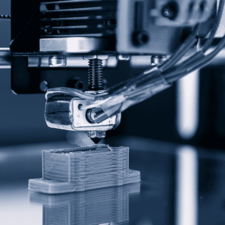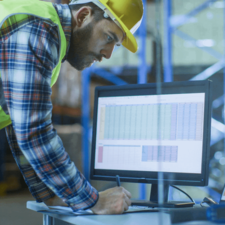Blog
How Metal 3D Printing is Transforming Metal Fabrication

Summary
Emerging technologies, such as metal 3D printing, are disrupting traditional methods of metal fabrication. Until recently, metal fabrication has involved a time-consuming process of casting and CNC machining, as well as tooling. It can take months and lots of money to design and manufacture metal parts at scale. But all that’s changing.
As in so many areas of the global economy, emerging technology is now disrupting traditional methods of metal fabrication. While 3D printing began years ago with plastic and other simple materials, it’s now increasingly available for printing metal parts from metals like stainless steel. Recent innovations include a type of 3D printing that’s an additive process, called “additive manufacturing” (AM). The AM process uses a laser beam to melt micron layers of metal powder instead of plastic filament.
Researching ERP and major industry trends?
Click to visit our ERP Resource Library, which includes white papers, ebooks, videos, case studies and more

New metal 3D printing machines, such as those made by Massachusetts-based Desktop Metal, enable 3D printing with a much wider variety of metals, which will simplify the process for metal fabrication. The new additive manufacturing would allow metal fabricators to print, for example, metal airplane parts quickly and at scale, replacing older fabrication methods of casting and CNC machining. Metal 3D printing has moved well beyond the small-scale, “make a single prototype” phase and into the mass manufacturing phase, though it’s only at the beginning of that second phase now.
How Metal 3D Printing Works
How does the technology of metal 3D printing work? Well, there are a number of approaches currently being developed. For example, Desktop Metal’s 3D metal printer is based on a technology it calls single-pass jetting, described this way by Forbes: it’s “a bi-directional printing process that uses more than 32,000 jets in conjunction with powder spreaders to jet millions of droplets per second. That creates high-resolution layers of metal that build up into a part with no tooling required.” The end result? Metal fabricators/manufacturers can create more metal parts in minutes instead of hours.

The ability to 3D Print metal objects is drastically changing the metal fabrication industry.
Costs of Additive Manufacturing Are Coming Down
While the possibilities created by emerging 3D metal printers are breathtaking, specifically the potential to produce metal parts quickly at scale without the need for tooling. the price tag on these “mass market” metal 3D printers can also be fairly breathtaking. For example, the latest Desktop Metal “mass market” 3D printer costs north of $1 million dollars. But costs will come down as new solutions and innovations get developed, and as big manufacturers like GE and Ford adopt and integrate the technology into its manufacturing operations.
Moore’s Law, typically applied to computing power, also applies to metal 3D printing. The law states that the capacity of technology will accelerate and that costs will come down over time as circuits/chips get more efficient and cheaper. The metal 3D printing technology will increasingly be able to do more metal fabrication faster, at lower cost and with different metals.
Growing Adoption of Metal 3D Printing
Early adopters of metal 3D printing have included seven of the world’s top ten automakers, as well as companies in industries ranging from medical devices to clothing. Ford Motor Company is now testing the 3D printing of auto parts. Another early adopter is Jabil, a manufacturer based in St. Petersburg, Florida, which makes a wide range of products from casings for iPhones to complex medical devices.
Early adopters of metal 3D printing have included seven of the world’s top ten automakers
“Jabil doesn’t do things where we want to have three or four [metal 3D printing] machines in a corner,” Jabil’s vice president of digital manufacturing John Dulchinos told Forbes. “We’re about finding applications where you leverage scale and manufacturing capability.” And as companies like Jabil and Ford find success with metal 3D printing, industry competitors are paying close attention.
Metal 3D Printing Will Support Reshoring of U.S. Jobs
One of the most noteworthy and exciting trends in metal fabrication over the last few years has been the reshoring of U.S. jobs, as companies have returned production stateside. There are currently over 12 million manufacturing jobs in the U.S., and metal fabrications ranks third in terms of U.S. manufacturing employment.
What’s behind this U.S. reshoring trend? It’s mostly been due to new technologies, such as automation and metal 3D printing, that have boosted productivity, as well as rising labor costs overseas. There’s a growing need among U.S. metal fabricators to find and hire high-quality, tech-savvy metal fabricators to fill worker shortages. Leveraging emerging technologies like 3D printing will require a careful, dynamic blending of human skill and emerging additive manufacturing technologies.

New technologies like metal 3D printing are bringing manufacturing jobs back into the US.
Metal 3D Printing: Becoming More Available and Cheaper
The takeaway here is clear: more companies, especially recent startups like Desktop Metal, are entering the new field of making metal 3D printers, moving the technology forward. These companies will offer various solutions for metal fabricators, customizing the right products for the right needs and the right customers. The benefits for metal fabricators are equally clear.
While the early adopters of the technology have been huge enterprises like GE, Boeing, and Ford, it’s clear that we’ll be seeing more mid-sized and smaller companies adopting metal 3D printing in the years ahead, as we move from pilots to larger-scale adoption.
Why An ERP System Matters
A great ERP system is the best way to future-proof your organization and business operations. Why? Because your ERP system allows you to seamlessly integrate emerging new technologies like metal 3D printing into your operations. A metal 3D printer is a device, after all, and like any other device, it can be fully integrated into the rest of your metal fabrication operations through your ERP system. For example, you’ll be able to receive CAD blueprints from a customer through your ERP system and automatically feed designs into your metal 3D printer for production.
Your ERP would also enable you to monitor the performance of your metal 3D printers, just as it allows you to monitor and coordinate your other equipment. Long story short? When you have a great ERP system in place, you’re able to adopt and integrate new technologies (like metal 3D printing) quickly into what you do, letting you work smarter and stay competitive. Think plug and play!
Ready to start an ERP selection process? Click to download the guide to ERP selection:
Selecting an ERP System in 7 Easy Steps



